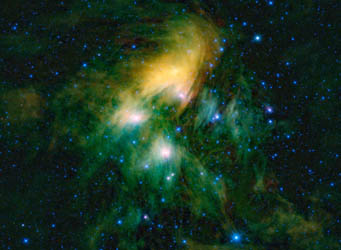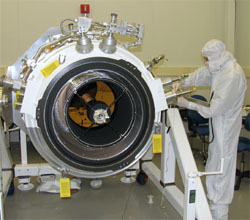Just two weeks ago I described how the European-built Planck spacecraft had completed an all-sky map of the microwave sky, with the goal of helping cosmologists learn more about the cosmic microwave background.

During the first six months of 2010, NASA's Wide-field Infrared Space Explorer methodically scanned the entire celestial sphere. It should complete a second scan, or nearly so, by the time its detectors' cryogenic coolant runs out.
NASA / JPL / WISE Team
Now another space observatory has completed a panoramic view of the universe. This time it's the work of WISE, short for Wide-field Infrared Space Explorer. The impending launch of WISE was Sky & Telescope's December 2009 cover story. Now NASA has announced that WISE finished its first complete scan of the sky on July 17th.
As with other space infrared telescopes, the meter is running on WISE's productive lifetime. Ever since its launch last December 14th, the frozen hydrogen used to cool WISE's heat-sensing detectors has been steadily dwindling. Engineers expect the cryogenic coolant to last about 10 months, and we're already seven months into that timetable.
So WISE has made the most of its time. Equipped with a 16-inch (40-cm) primary mirror, WISE's telescope delivers a 47-arcminute field of view to megapixel detector arrays tuned to the mid-infrared wavelengths of 3.4, 4.6, 12, and 22 microns. From its 15-revs-per-day, Sun-synchronous polar orbit, WISE sweeps over each point on the sky at least 8 to 10 times before moving on.

The Pleiades cluster as seen through the mid-infrared eyes of NASA's Wide-field Infrared Survey Explorer. The complete mosaic contains a few hundred image frames and covers 3.05° by 2.33°. Click here to see a larger view — or here for the full-resolution, 4,095-pixel-square original (note: it's a 23-megabyte file).
NASA / JPL / WISE Team
Seen through mid-infrared eyes, the universe is full of wonderful sights. Take, for example, the not-so-familiar Pleiades seen at right. We're all used to seeing this open cluster's stars against black space like so many diamonds scattered on black velvet. Human eyes are barely equipped to glimpse the faint nebulosity that envelops them, but it's a completely different view when seen in the infrared. The nebula was once thought to be left over from the cluster's formation. But the Pleiades are roughly 100 million years old — too long for that embryonic dust to linger. Instead, the cluster seems to be passing though an unrelated interstellar cloud.
Pretty pictures aside, WISE's observations should break new ground in the study of brown dwarfs, especially those below about 1,400°F (1,000 kelvins), and all manner of energetic cosmic sources so distant that their emissions have been redshifted to mid-infrared wavelengths. Astronomers will get their hands on the data next May, when mission scientists plan to make about 80 percent of the all-sky coverage available.
WISE has already made a lasting contribution to solar-system science, because it has identified more than 100,000 asteroids. Most of these were previously known and in the main belt between Mars and Jupiter. But more than 200 of them are near-Earth asteroids, and roughly a quarter of these are new finds.
A typical space rock is within the telescope's view for less than 36 hours, not long enough to nail down its orbit precisely. Yet the detections are giving impact specialists something that's arguably just as valuable: size estimates.

The WISE space observatory features a 16-inch (40-cm) primary mirror that's overcoated with gold, as seen here. The spacecraft was launched with 33 pounds (15 kg) of frozen hydrogen, enough to keep the detectors at their supercold best for about 10 months.
NASA
With an asteroid of a given visible-light magnitude, the observer can't tell if it's very dark and big — or very light-colored and small. That's because the light we see is reflected sunlight. WISE sidesteps this problem because asteroids all glow brightly in the mid-infrared with their own emitted light. So, impact specialists are hoping that the new observations will yield more accurate sizes for NEOs and thus quantify better how much of a threat they pose to Earth.
Meanwhile, the spacecraft continues to rescan the sky. According to project scientist Ned Wright (University of California, Los Angeles), the spacecraft has an outside chance of completing another complete scan. "We expect the big hydrogen tank will run out in early November, plus 4 weeks, minus 2 weeks," he told me via email. "So lasting into December is within the range of uncertainty."
To learn more about this exciting mission, check out the WISE website or download this two-page overview.
 2
2
Comments
Navneeth
July 20, 2010 at 1:28 am
The first line of the article should read "Just two weeks ago I described how the European-built Planck... ."
You must be logged in to post a comment.
earl
July 27, 2010 at 6:25 am
will iformation from this wide eyed view be screened and filterd or will the findings be ginuinely tamper free. Has there been any findings which might show useable material for mineing or some type of procurement to facilitate space travel or moon base projects. are any of the new objects on an orbit of 3600 years.
You must be logged in to post a comment.
You must be logged in to post a comment.